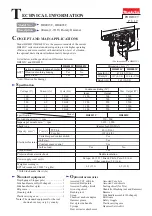
8957409
120V 1,900 BPM SDS Demolition Hammer Kit
V4.0
4
For technical questions call 1-800-665-8685
influence of drugs, alcohol, or medication. A moment of inattention while
operating the tool may result in serious personal injury.
•
Dress properly. Do not wear loose clothing, dangling objects, or jewelry.
Keep your hair, clothing and gloves away from moving parts. Loose clothes,
jewelry, or long hair can be caught in moving parts. Air vents on the tool
often cover moving parts and should be avoided.
•
Wear the proper personal protective equipment when necessary. Use ANSI
Z87.1 compliant safety goggles (not safety glasses) with side shields, or
when needed, a face shield. Use a dust mask in dusty work conditions. Also
use non-skid safety shoes, hardhat, gloves, dust collection systems, and
hearing protection when appropriate. This applies to all persons in the work
area.
•
Do not overreach. Keep proper footing and balance at all times.
•
Remove keys or wrenches before connecting the tool to an air supply,
power supply, or turning on the tool. A wrench or key that is left attached to
a rotating part of the tool may cause personal injury.
•
Secure the work with clamps or a vise instead of your hand when practical.
This safety precaution allows for proper tool operation using both hands.
DEMOLITION BREAKER HAMMER USE AND CARE
CAUTION
•
Do not force the demolition hammer. Products are safer and do a better job
when used in the manner for which they are designed. Plan your work, and
use the correct product for the job.
•
Check for damaged parts before each use. Carefully check that the product
will operate properly and perform its intended function. Replace damaged
or worn parts immediately. Never operate the product with a damaged part.
•
Do not use a product with a malfunctioning switch. Any power tool that
cannot be controlled with the power switch is dangerous and must be
repaired by an authorized service representative before using.
•
Disconnect the power/air supply from the product and place the switch in
the locked or off position before making any adjustments, changing
accessories, or storing the tool. Such preventive safety measures reduce
the risk of starting the tool accidentally.





































